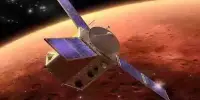ANI, December 14, Washington (US): The first functional microphone on the surface of Mars was installed in the rover Perseverance when it first touched down there. It was utilized by researchers to capture the first-ever audio of an extraterrestrial whirlwind.
Naomi Murdoch, a planetary scientist, and a group of researchers from NASA, the National Higher French Institute of Aeronautics and Space, and other institutions published their findings in the journal Nature Communications. The instrument team that produced the discovery is led by Roger Wiens, professor of earth, atmospheric, and planetary sciences at Purdue University. He is in charge of Perseverance’s SuperCam, a collection of instruments that make up the rover’s “head” and include sophisticated remote-sensing equipment with a variety of spectrometers, cameras, and the microphone.

Sound is a much more effective teaching technique than certain other ones, according to Wiens. Readings are taken at regular intervals. We can sample with the microphone almost 100,000 times per second, which is close to the speed of sound. It gives us a better understanding of Mars’ characteristics.
Every few days, the microphone records for around three minutes instead of being on all the time. Wiens claimed that while not necessarily unexpected, getting the whirlwind recording was fortunate. Since Perseverance’s landing in the Jezero Crater, the team has seen evidence of approximately 100 dust devils, or miniature dust and grit tornadoes. The microphone was turned on for the first time as one flew over the rover.
Together with air pressure measurements and time-lapse photos, the dust devil sound recording aids in the understanding of the Martian weather and atmosphere.
We may observe the pressure drop, hear the wind, experience a brief period of calm that represents the eye of the small storm, and then hear the wind once more as we observe the pressure rise, according to Wiens. Everything happened in a flash. The wind is strong, blowing at roughly 25 mph, yet it is similar to what you would see in a dust devil on Earth. On Mars, the air pressure is so much lower than on Earth that even if the winds are just as strong, they exert just approximately 1% of the force they would have there. Although not particularly strong, the wind is evident enough to lift grit into the air and create a dust devil.
According to the information, future astronauts won’t have to worry about gale-force winds tearing down antennae or habitats, meaning there won’t be any Mark Watneys left behind. However, the wind might even have certain advantages. Other rovers, especially Opportunity and Spirit, may have lasted longer due to breezes clearing grit off their solar panels.
“Those rover teams would experience a gradual reduction in power over a few days to weeks, followed by an increase. The solar panels were wind-free at that point, according to Wiens.
Why the InSight mission is coming to an end might be explained by the absence of such wind and dust devils on the Elysium Planitia where the mission landed.
The weather on Mars varies depending on where you are, much like it does on Earth, according to Wiens. The microphone, in particular, “helps us gain a concrete feeling of what it would be like to be on Mars” by allowing us to use all of our instruments and gear. (ANI)
This report was generated automatically by the ANI news service. ThePrint is not liable for its contents.
















